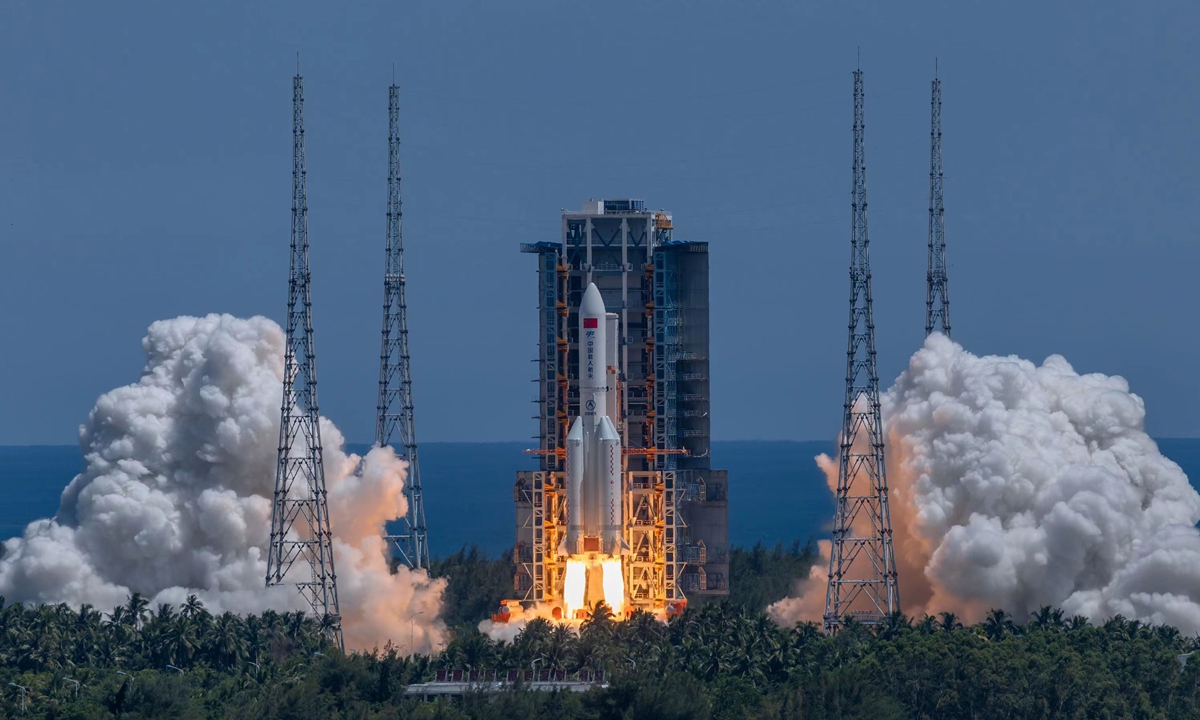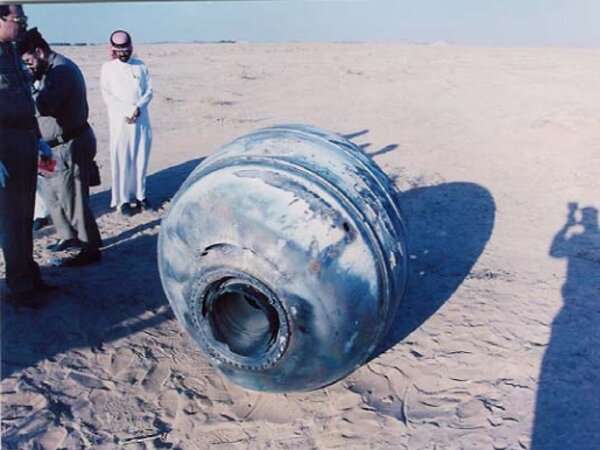re-entry, despite flawless safety record
By GT staff reporters

China launches Wentian lab module for space station on July 24, 2022.
Right after China's successful launch of the Wentian lab module for the construction of the China Space Station, the Western media rapidly followed with a new round of smear campaign, hyping the "uncontrolled fall" of the Long March-5B Y3 carrier rocket's first stage.
Mission insiders at the rocket's developer and space analysts reached by the Global Times on Tuesday said that they were not surprised by such ignorant manipulation of facts, which projected once again the "sour grapes" mentality of some in the West toward the robust development of China's aerospace sector.
Media such as space.com claimed in its coverage of the Wentian mission that it was the third time that China "has opted not to control the disposal of the first stage of the Long March 5B rocket, once again putting China under scrutiny from space debris trackers after similar uncontrolled falls in 2020 and 2021."
Jonathan McDowell, an experienced tracker of these events at the Harvard-Smithsonian Center for Astrophysics, was quoted in these reports as saying that US Space Command orbital data is showing the 21-ton stage floating on its own.
"The inert ... core stage remains in orbit and was not actively deorbited," McDowell wrote on Twitter. McDowell added that Americans "do a rather better job of upper stage disposal, and China on average a worse one.
"So, I congratulate China on the successful launch of Wentian but deplore their failure to redesign the Long March 5B that sets us up for another major uncontrolled re-entry," the US astronomer told spacenews.com, further emphasizing his theory.
Commenting on these almost routine accusations, a mission insider at the rocket developer China Academy of Launch Vehicle Technology (CALT) told the Global Times on Tuesday that "There is no specific adjustment made to the rocket used in the Wentian launch in terms of the re-entry issues. And the mission was executed strictly in line with international practice, as the country always did in previous space launches."
The so-called Western experts should come back to reality, where the truth has proven to be the opposite of their accusations again and again, and they'd better do so, as we still have the Mengtian launch coming next, the insider said on condition of anonymity.
It was not the first time that the West has picked on the Long March-5B, a shorter variant of the country's strongest Long March-5 rocket type that has been deployed for China Space Station module launches.
The US made quite a fuss over the Long March-5B Y2 debris' re-entry in May 2021, when the rocket was commissioned to deliver the Tianhe core module.
CALT rocket designer Zhang Borong told the Global Times in May 2021 that the rocket adopted passivation technology that would not cause any explosion in orbit or create debris in space, and that rocket debris would be burned up by friction with the atmosphere, rather than smashing into Earth as in sci-fi movies.
Turning a deaf ear to repeated statements by China's space industry insiders and the Foreign Ministry that the probability of the rocket remnants causing harm was extremely low, a number of Western media outlets, including CNN and The New York Times, as well as the Pentagon and NASA, claimed during the Tianhe mission that the debris was heading back to Earth in an "uncontrolled" manner and criticized China for being "irresponsible" for the ocean landing.
The last round of the US-led smear campaign against Long March-5B was met with "slaps in the face," as the facts proved that the re-entry of the rocket remnants was harmless.
In fact, the China Manned Space Agency (CMSA) has regularly updated orbit data for debris re-entry of any rockets or spacecraft used for the China Space Station's construction, such as that for the Long March-2F rocket as well as the Tianzhou cargo spacecraft, which fully conforms to international norms in a rather responsible fashion, analysts said.
The CALT source told the Global Times that it saddened them that the Western world has adopted such obscurantism that it uses twisted facts to fool its people, citing another hyped report that said Tiangong Classroom sessions were filmed on Earth rather than in space.
"China ruled out the possibility of causing ground damage at the design stage, and its capability to ensure the re-entry safety has proven itself reliable again and again. What is behind such smears is total jealousy of us," Song Zhongping, a TV commentator who closely follows China's space program, told the Global Times on Tuesday.
The US is running out of ways to stop China's development in the aerospace sector, so smears and defamation became the only things left for it, Song noted. "But those efforts would be useless to affect the development of the China space program."
Scientists calculate the risk of someone being killed by space junk

The chance of someone being killed by space junk falling from the sky may seem ridiculously tiny. After all, nobody has yet died from such an accident, though there have been instances of injury and damage to property. But given that we are launching an increasing number of satellites, rockets and probes into space, do we need to start taking the risk more seriously?
A new study, published in Nature Astronomy, has estimated the chance of causalities from falling rocket parts over the next ten years.
Every minute of every day, debris rains down on us from space—a hazard we are almost completely unaware of. The microscopic particles from asteroids and comets patter down through the atmosphere to settle unnoticed on the Earth's surface—adding up to around 40,000 metric tons of dust each year.
While this is not a problem for us, such debris can do damage to spacecraft—as was recently reported for the James Webb space telescope. Occasionally, a larger sample arrives as a meteorite, and maybe once every 100 years or so, a body tens of meters across manages to drive through the atmosphere to excavate a crater.
And—fortunately very rarely—kilometer-sized objects can make it to the surface, causing death and destruction—as shown by the lack of dinosaurs roaming the Earth today. These are examples of natural space debris, the uncontrolled arrival of which is unpredictable and spread more or less evenly across the globe.
The new study, however, investigated the uncontrolled arrival of artificial space debris, such as spent rocket stages, associated with rocket launches and satellites. Using mathematical modeling of the inclinations and orbits of rocket parts in space and population density below them, as well as 30 years' worth of past satellite data, the authors estimated where rocket debris and other pieces of space junk land when they fall back to Earth.
They found that there is a small, but significant, risk of parts re-entering in the coming decade. But this is more likely to happen over southern latitudes than northern ones. In fact, the study estimated that rocket bodies are approximately three times more likely to land at the latitudes of Jakarta in Indonesia, Dhaka in Bangladesh or Lagos in Nigeria than those of New York in t
The authors also calculated a "casualty expectation"—the risk to human life—over the next decade as a result of uncontrolled rocket re-entries. Assuming that each re-entry spreads lethal debris over an area of ten square meters, they found that there is a 10% chance of one or more casualties over the next decade, on average.
To date, the potential for debris from satellites and rockets to cause harm at the Earth's surface (or in the atmosphere to air traffic) has been regarded as negligible. Most studies of such space debris have focused on the risk generated in orbit by defunct satellites which might obstruct the safe operation of functioning satellites. Unused fuel and batteries also lead to explosions in orbit which generate additional waste.
But as the number of entries into the rocket launch business increases—and moves from government to private enterprise—it is highly likely that the number of accidents, both in space and on Earth, such as that which followed the launch of the Chinese Long March 5b, will also increase. The new study warns that the 10% figure is therefore a conservative estimate.

What can be done
There are a range of technologies that make it entirely possible to control the re-entry of debris, but they are expensive to implement. For example, spacecraft can be "passivated," whereby unused energy (such as fuel or batteries) is expended rather than stored once the lifetime of the spacecraft has ended.
The choice of orbit for a satellite can also reduce the chance of producing debris. A defunct satellite can be programmed to move into low Earth orbit, where it will burn up.
There are also attempts to launch re-usable rockets which, for example, SpaceX has demonstrated and Blue Origin is developing. These create a lot less debris, though there will be some from paint and metal shavings, as they return to Earth in a controlled way.
Many agencies do take the risks seriously. The European Space Agency is planning a mission to attempt the capture and removal of space debris with a four-armed robot. The UN, through its Office of Outer Space Affairs, issued a set of Space Debris Mitigation Guidelines in 2010, which was reinforced in 2018. However, as the authors behind the new study point out, these are guidelines, not international law, and do not give specifics as to how mitigation activities should be implemented or controlled.
The study argues that advancing technologies and more thoughtful mission design would reduce the rate of uncontrolled re-entry of spacecraft debris, decreasing the hazard risk across the globe. It states that "uncontrolled rocket body reentries constitute a collective action problem; solutions exist, but every launching state must adopt them."
A requirement for governments to act together is not unprecedented, as shown by the agreement to ban ozone layer-destroying chlorofluorcarbon chemicals. But, rather sadly, this kind of action usually requires a major event with significant consequences for the northern hemisphere before action is taken. And changes to international protocols and conventions take time.
In five years, it will be 70 years since the launch of the first satellite into space. It would be a fitting celebration of that event if it could be marked by a strengthened and mandatory international treaty on space debris, ratified by all UN states. Ultimately, all nations would benefit from such an agreement.Uncontrolled rocket descents pose a 10% risk of killing one or more people over the next ten years
More information: Michael Byers et al, Unnecessary risks created by uncontrolled rocket reentries, Nature Astronomy (2022). DOI: 10.1038/s41550-022-01718-8
Journal information: Nature Astronomy
Provided by The Conversation
No comments:
Post a Comment